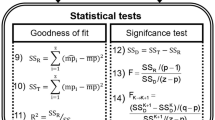Abstract
From the point of view of safety applications, accurate and reliable positioning system for road users is the most important part. Although GPSs are the most widely utilized technology today, they still have the problems of performance degradation caused by multipath propagation in urban canyons. This study proposes an approach to estimate position by searching around the result of GPS. The proposed algorithm evaluates the pseudoranges of the possible multipath signals by referring to the building geometry. The assumed position is estimated by using received pseudoranges and is evaluated by the likelihood of the possible positioning error and filtering algorithm. The proposed method was verified through field experiments in urban canyons in Tokyo.









Similar content being viewed by others
References
MacGougan, G., Lachapelle, G., Klukas, R., Siu, K., Garin, L., Shewfelt, J., Cox, G.: Performance analysis of a stand-alone high-sensitivity receiver. GPS Solutions 6(3), 179–195 (2002)
Wang, J.H., Gao, Y.: High-sensitivity GPS data classification based on signal degradation conditions. Vehicular Technology, IEEE Transactions 56(2), 566–574 (2007)
Garin, L., and Rousseau, J. M.: Enhanced strobe correlator multipath rejection for code & carrier. In Proceedings of the 10th International Technical Meeting of the Satellite Division of The Institute of Navigation (ION GPS 1997), pp. 559–568. (1997)
Van Dierendonck, A.J., Fenton, P., Ford, T.: Theory and performance of narrow correlator spacing in a GPS receiver. Navigation 39(3), 265–283 (1992)
Townsend, B., Fenton, P.: A practical approach to the reduction of pseudorange multipath errors in a L1 GPS receiver. In Proceedings of the 7th International Technical Meeting of the Satellite Division of the Institute of Navigation, Salt Lake City, UT, USA, (1994)
M. S. Braasch, “Performance comparison of multipath mitigating receiver architectures,” in Aerospace Conference, 2001, IEEE Proceedings., 2001, vol. 3, pp. 3/1309 –3/1315 vol.3.
Townsend, B.R., Fenton, P.C., Van Dierendonck, K.J., Van Nee, D.J.R.: Performance evaluation of the multipath estimating delay lock loop. Navigation-Los Angeles and Washington 42, 503–514 (1995)
Fenton, P. C., Jones, J.: The theory and performance of NovAtel Inc.’s vision correlator. ION GNSS, (2005).
Knoop, V. L., Buist, P. J.,Tiberius, C. C. J. M., van Arem, B.: Automated lane identification using precise point positioning an affordable and accurate GPS technique. 15th International IEEE Annual Conference on Intelligent Transportation Systems, (2012).
Suzuki, T., Kitamura, M., Amano, Y., Hashizume, T.: High-accuracy GPS and GLONASS positioning by multipath mitigation using omnidirectional infrared camera. In Robotics and Automation (ICRA), 2011 I.E. International Conference on, pp. 311–316. (2011)
Suh, Y., Shibasaki, R.: Evaluation of satellite-based navigation services in complex urban environments using a three-dimensional GIS. IEICE transactions on communications 90(7), 1816–1825 (2007)
Costa, E.: Simulation of the effects of different urban environments on GPS performance using digital elevation models and building databases. Intelligent Transportation Systems, IEEE Transactions on 12(3), 819–829 (2011)
Marais, J., Berbineau, M., Heddebaut, M.: Land mobile GNSS availability and multipath evaluation tool. Vehicular Technology, IEEE Transactions on 54(5), 1697–1704 (2005)
Brown, R.: A baseline GPS RAIM scheme and a note on the equivalence of three RAIM methods. Navigation 39(3), 301–316 (1992)
Lee, Y. C., O’Laughlin, D. G.: A performance analysis of a tightly coupled GPS/inertial system for two integrity monitoring methods. Proceedings of ION GPS, Nashville, pp. 14–17, (1999)
Peyret, F., Bétaille, D., Florian, M., Non-Line-Of-Sight GNSS signal detection using an on-board 3D model of buildings. Proceedings of the IEEE ITST (2011)
Peyret, F., Bétaille, D., Ortiz, M., Miquel, S., Fontenay, L.: How to improve GNSS positioning Quality of Service for demanding ITS in city environments by using 3D digital maps. 19th ITS World Congress, Vienna (2012)
Obst, M., Bauer, S., Reisdorf, P., Wanielik, G.: Multipath detection with 3D digital maps for robust multi-constellation GNSS/INS vehicle localization in urban areas. Intelligent Vehicles Symposium IV, 184–190 (2012)
Pinana-Diaz, C., Toledo-Moreo, R., Betaille, D., Gomez-Skarmeta, A. F.: GPS multipath detection and exclusion with elevation-enhanced maps. In Intelligent transportation systems (ITSC), 2011 14th International IEEE Conference on, pp. 19–24. (2011)
Iwase, T., Suzuki, N., Watanabe, Y.: Estimation and exclusion of multipath range error for robust positioning. GPS solutions 17(1), 53–62 (2013)
Kaplan, E. D., Hegarty, C. J.: Understanding GPS: Principles and applications. Artech house (2005)
Author information
Authors and Affiliations
Corresponding author
Rights and permissions
About this article
Cite this article
Miura, S., Kamijo, S. GPS Error Correction by Multipath Adaptation. Int. J. ITS Res. 13, 1–8 (2015). https://doi.org/10.1007/s13177-013-0073-9
Received:
Accepted:
Published:
Issue Date:
DOI: https://doi.org/10.1007/s13177-013-0073-9




